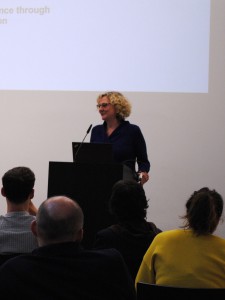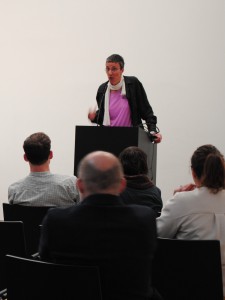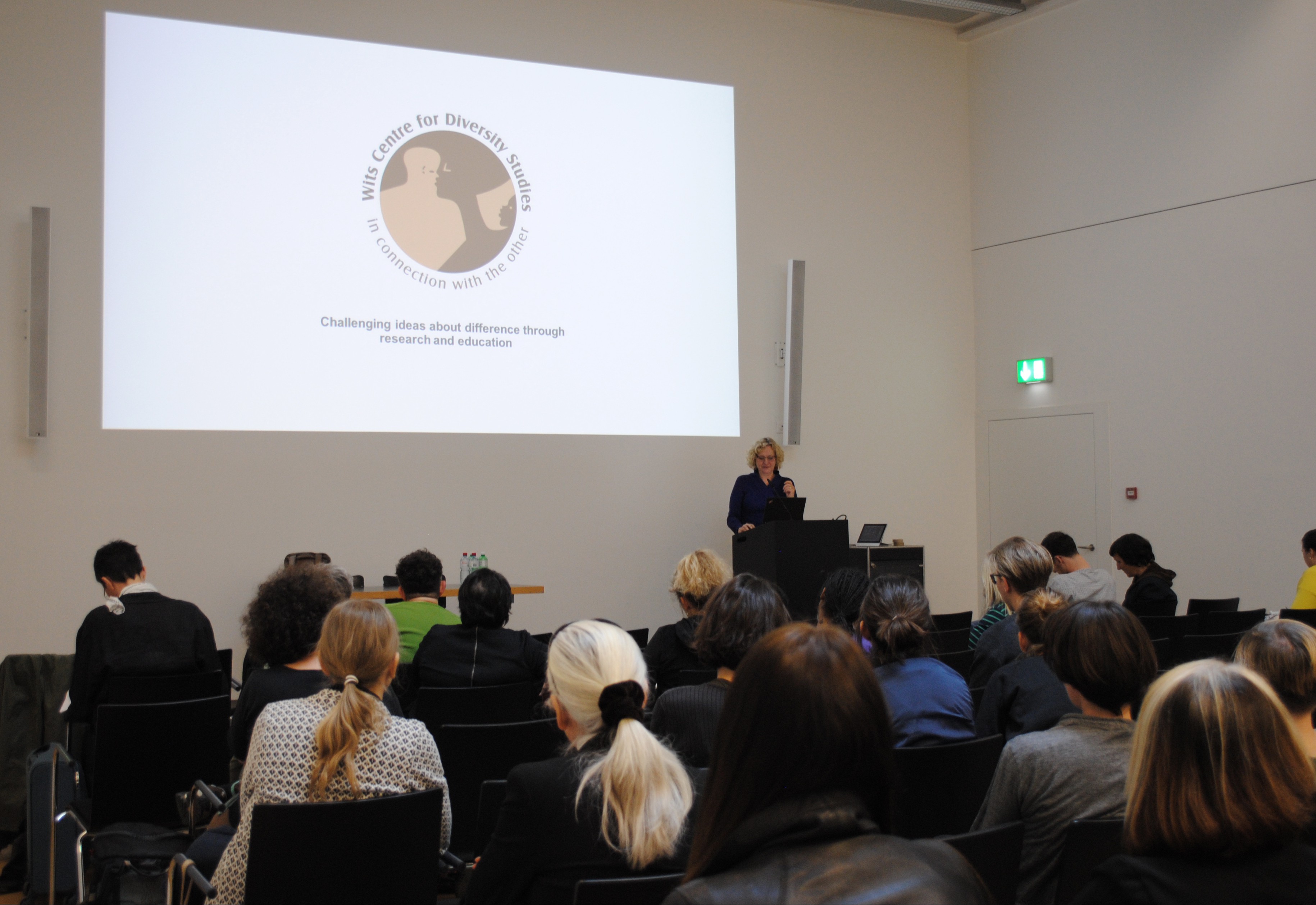Colloquium no. 4 Friday 24th April 2015, 18.00 at ZHdK
Radical lectures delivered in less radical institutional settings tend to be opened by official welcome notes that are well-intended, but often boring or that even downplay the radical stance the lecture itself is about to propose. This was not the case on April 24th, when David Keller, head of International Affairs at ZHdK, welcomed Melissa Steyn and Marie Buscatto in Zurich. In front of a full house, Keller opened the evening by acknowledging the ambivalence of his own position, as a “super privileged, white, heterosexual man from a middle-class background,” in the context of a programme that aims to destabilise the hegemony of that very position.
Having been involved with literacy projects in development cooperation in Latin America, Keller was particularly interested in Steyn’s concept of “critical diversity literacy.” Steyn argues that “those socialized into spaces of relative disadvantage tend to be more literate in critical diversity,” than those who are born into positions of privilege. Taking this statement at face value, Keller wondered if he was invited to attend the evening in order to improve his own “diversity literacy,” hence his own capacity to read and recognize processes of discrimination, by being exposed to an experience of multiple exclusion himself (as supposeldy one of the few straight white men in the lecture hall). While this remark might have sounded a bit heavier than intended, it does speak to the spectre haunting those who are indeed comfortably occupying privileged social positions.
Without justifying those who feel pressured, threatened or even “discriminated” against when confronted with the demands of a critical diversity agenda, Keller suggested that such (defensive) responses indicate that “something powerful is coming.” Further, he held that Paulo Freire’s major work “Pedagogy of the Oppressed” should be inverted and rewritten into a ”Pedagogy for the Oppressor“ who is ready to work on his ”failed socialization“ and be educated on the injustices he did not learn to see. Keller closed his opening remarks by welcoming Melissa Steyn as the “critical friend” needed to ask provocative questions and offer her critique.
Keller was followed by Carmen Mörsch, head of the institute for Art Education, who introduced the lecturers in more detail, after assuring Keller that Art.School.Differences project considers him an ally: Keller’s attempts at reflecting on ZHdK’s process of internationalization by discussing critical theories were, she said, highly appreciated by the Art.School.Differences team.
18.15h
Melissa Steyn (Wits Centre for Diversity Studies, University of the Witwatersrand, Johannesburg)
Getting into focus for the 21st Century: Critical Diversity Literacy as an essential lens

Melissa Steyn, best known for her work on whiteness in post-Apartheid South Africa, has been developing Diversity Studies as field in Higher Education since 2001. She holds the South African National Chair in Critical Diversity Studies and is the founding director of the Wits Center for Diversity Studies, which challenges ideas about difference through research and education.
Steyn understands diversity as a mode of “being different together“ that is enabling for everybody. As simple as this may sound, in reality it’s complicated. Especially since diversity has become a core trope for the world and since claims to be in favour of diversity have become standard – not least in Higher Art Education. Steyn’s framework of “Critical Diversity Literacy“ accounts for the fact that achieving true diversity is a struggle that is far from being a carnivalesque celebration and consumption of differences, as neo-liberalism tries to make us believe. This critical type of literacy is much more than a private, cognitive skill to encode and decode written texts. Rather, this literacy connotes the socially and culturally embedded capacity of reading, or, drawing on France Winddance Twine, “of receiving and responding to a social climate and prevalent structures of oppression.” [1]
Steyn defines Critical Diversity Literacy (CDL) as “an informed analytical orientation that enables a person to ‘read’ prevailing social relations as one would a text, recognizing the ways in which possibilities are being opened up or closed down for those differently positioned within“ a specific social context. For years, Steyn has been working on and extending the criteria to assess (someone’s) CDL. I will focus on three of the ten critical points she outlined in Zurich:
1. an understanding of the role of power in the construction of differences that make a difference.
Point one gets at the heart of how the social is constructed. It conveys that unequal power dynamics are the medium through which differences become salient. We first need to detect the discourses that hold centres and margins in place and determine whose life opportunities are restricted and whose are enabled as a result. This can only be done by putting power at the centre of analysis.
2. recognition of the unequal symbolic and material values of different social locations. This includes acknowledging hegemonic positionalities and concomitant identities and how these position non-hegemonic others.
Dominant groups are the ones who possess the freedom to define which differences matter. The privileged have the power of define the oppressed populations as the others. While these others may also have internalized normative understanding of themselves (as an example Steyn mentions that “good Blacks“ in South Africa perform their blackness in a way that makes whites feel comfortable), they still tend to have a better more receptive understanding of how social dynamics of exclusion are operating.
9. understanding the role of emotions, including our own emotional investments, in all of the above
As affect theory has shown, the way we feel about others and about ourselves, our emotional responses are not inevitable or “natural”, but acquired. Through socialisation we learn who we are supposed to trust and feel close to, and who we are supposed to fear. CDL requires the willingness to explore of our sense of self and to recognise our privilege or complicity. However uncomfortable this process be, becoming aware of how we have been shaped emotionally is crucial to the process in letting go routinized responses and becoming critical diversity literates.
Last but not least, as Steyn emphasizes, point ten reminds us that critical diversity literacy implies not just the capacity to read but also the capacity to (re)write the script that lead to exclusions:
10. an engagement with transformation of those oppressive systems towards deepening social justice at all levels.
While I have picked out four point that seem particularly relevant to myself, you should consult the powerpoint presentation in which Melissa Steyn names all the ten criteria she developed: Presentation Melissa Steyn
Discussion:
Steyn’s insistence on a critical perspective reflects that un-critical diversity projects are part and parcel of neo-liberal agendas. The fact that diversity is a form of literacy that needs to be acquired (rather than consumed and celebrated), implies that it is crucial to focus on power dynamics. Steyn understands diversity as struggle against existing power blocks that need to be changed. Asked about the strategies of survival of those who try to enact critical diversity literacy, Steyn pointed out that it is important of being aware of how draining and “dangerous” this work can be. Comparing the Swiss situation of diversity and its study to the South African engagement with diversity, Steyn holds that it is in fact harder to persuade the “centers” (like Switzerland) to shift. In South Africa discussions concerning the need for critical diversity are held less politely and with an urgency that is perhaps necessary to make changes.
19.15
Marie Buscatto (Université Paris 1 Panthéon Sorbonne)
Art worlds as gendered worlds

Marie Buscatto is well-known for her empirical work on “artistic practices as gendered practices.” An amateur jazz musician herself, she has used both ethnographic and classical sociological methods in exploring the role of female artists in the world of jazz in particular. In her presentation at ZHdK she set out to explain why men in arts “always fare better than women in terms of becoming and remaining recognized as artists,” and why, nevertheless, increasing numbers of female artists are being successful. With regard to her binary use of gender categories (“woman” / “man”), Buscatto sent ahead that she considered “transsexuals” a recent and relatively marginal phenomenon that she did not consider in her study.
Despite the public perception about the open-minded of the art world, it is highly gendered in ways that leads to the marginalisation of female performers over time. Here’s a summary of the main points of this gradual, cumulative process:
1. as in other professional fields, female performers are overrepresented in devaluated, feminine connoted areas such as dancing and singing. In jazz this imbalance is striking – 96% of all instrumentalists are male and 65% of all singers are female – and reflects how the gendered order is naturalized in music from an early age. Boys, for instance, may be encouraged to pick up an electric guitar and allowed to explore informal (musical) environments, whereas girls are rather called into learning formal, classical instruments.
2. socializing works better for male than for female performers. Buscatto mentions that it is difficult to feel comfortable as a woman in an otherwise all male band, because the men “don’t feel comfortable with you either.” To the men feels safer to play (music) with colleagues of your own gender, and, as I would add your own race.
3. persistent stereotype about women not being powerful creators, complicates recognition as an independent female artist. When female pop musicians do become famous, it’s assumed that someone else writes their hits for them, that they are backed by powerful boyfriends, or that it is their (physical) seductiveness that makes them successful. Male seduction, however, is associated with action and creativity.
4. women struggle to articulate private and professional life not because they have children, but rather, because unlike their male who are backed by a helpful girlfriend, heterosexual female artists tend to have lovers who are themselves busy artists and less prepared to cater to their partner’s career and professional needs.
Nevertheless, a number of factors have contributed to the raising numbers in women in art, since female artists are strategically:
1. turning feminine stereotypes into an asset; women artists in particularly “feminine” and devaluated fields (such as knitting) managed to revert stigma and end up being considered original.
2. consciously or unconsciously deploying “feminine capital such as seduction” as a marketing strategy, while remaining aware that drawing on certain stereotypes is counterproductive, because it makes you a “feminine artists” and not a universal artist.
3. “compensating” exclusions by drawing on formal funding programmes and/or on their class privileges. Generally, female musicians are equipped with more cultural capital and have better access to (male) social networks.
– they tend to have higher educational degrees than men; art schools are efficient in allowing young women to practice networking and performance skills that are hard to gain in stigmatizing, informal spaces.
– public funding and projects for underprivileged youth in popular music and dance seem to have a positive effect for women.
– it has been shown that the use of screens to hire orchestra musicians has elevated the percentage of female orchestra musicians by 30%.
4. involving themselves in collective action and commercial and/or feminist initiatives organized for (or by) all-female bands and groups of artists.
Discussion:
While appreciating Buscatto’s empirical findings, her neglect of intersectional and historical works by black and queer theorists was critiqued. First, her pre-empting comment about trans*issues being a recent phenomena was interrogated on the basis that gender-queers (people transgressing gender binaries in various in/visible ways) have existed long before the term trans* gained currency. The risk of reproducing certain stereotypes (e.g. about women’s use of seduction) looms large, when gender binaries are taken for granted. This leads to an epistemological blind spot, for instance on the structuring effects of what queer theorists identified as “male homosociality” or on what disables or allows for the reversal of certain stigmatizations and not others. Further, it would be interesting to consider contemporary female performers who reject to play on their femininity (by wearing baggy clothes ect) against the background of a long history of female musicians who cross-dressed and/or passed as men in performance spaces. This “queering” of the gaze does not mean we look for “homosexuals.” It compels us, however, to consider strategies of seduction or of non-seduction by making use of interdisciplinary theories on the intertwinement of gender and sexuality.
The discussion continued the following day in the colloquium among the professors and co-researchers during the Art.School.Differences colloquium. It illuminated the challenge of communicating across disciplines and the need to connect sociological research tools to cultural theories in order to understand the many faces of exclusion.
[1] France Winddance Twine refers to reading practices in the context of what she coined as “racial literacy.”
Serena O. Dankwa
is a classical musician who became a radio journalist who became a black feminist anthropologist
https://www.zhdk.ch/?person/detail&id=201721
